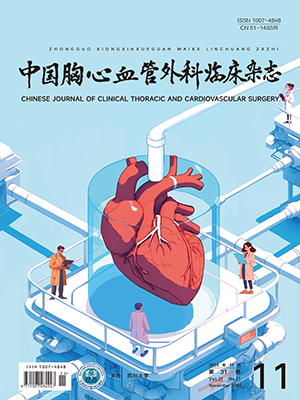Corresponding author: XU Zhi-wei, E-mail: zwxumd@online.sh.cn Abstract: Objective To compare the two different ways of right ventricle pulmonary artery (RV-PA) reconstruction at repair of persistent truncus arteriosus(PTA), the direct RV-PA anastomosis and extra conduit connection, in order to find the better way. Methods From Feb. 2000 to Sept. 2006, 23 patients had undergone the repairs of truncus arteriosus in our hospital, age at operation from 1.5 to 63.3 months. Patients were divided into 2 groups according to the way of RV PA reconstruction. Group Ⅰ : 18 of them, using direct RV-PA anastomosis, group Ⅱ : 5 of them, using valved homograft or Gore-Tex conduit. 3 patients were associated with interrupted aortic arch (IAA). Kaplan-Meier was used to calculate postoperative mortality, survival time and re-operation situation. Paired t-test and group t-test were used to evaluate late pulmonary growth and cardiac function.Results There were 2 early hospital death, there were 17 patients in follow-up for 2.14 ± 1.97y (32.00d-6.95y). No later death during follow-up. Total survival rateo was 91.30%(21/23), 95% CI of survival time was 5.55-7.15y. Survival ratio of group Ⅰ was 94.40%, and that of group Ⅱ was 80%. One patient had undergone re operation for right ventricular outflow tract obstruction (RVOTO). The difference between the diameter of postoperative RV-PA anastomosis was statistically significant. The early diameter of group Ⅰ was 1.01 ± 0.26cm, later was 1.32 ± 0.45cm(P=0.019). The velocity of flow at the position of anastomosis and the peristome of right pulmonary artery (RPA)/left pulmonary artery (LPA) was acceptable. Compared the postoperative cardiac function, late left ventricle ejection fraction (LVEF) really improved with a significant difference [ group Ⅰ , early was 62.82%, late was 69.87%(P=0.026); group Ⅱ , early was 58.17%, late was 64.00%(P=0.029) ] . No re-operation for truncal valve regurgitation was needed. Conclusions The postoperative survival and follow-up results are satisfactory. A direct anastomosis of RV-PA continuity has the potential for right ventricle outflow tract (RVOT) growth and associated with low rate of pulmonary artery and bifurcation obstruction. The heart function is really improved during follow-up. IAA and truncal valve regurgitation are two major risk factors of associated with hospital death.
Citation: SHEN Jia,XU Zhiwei. Repair of Truncus Arteriosus: Choice of Right Ventricle Outflow Tract Reconstruction. Chinese Journal of Clinical Thoracic and Cardiovascular Surgery, 2008, 15(2): 81-86. doi: Copy




